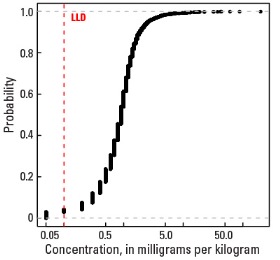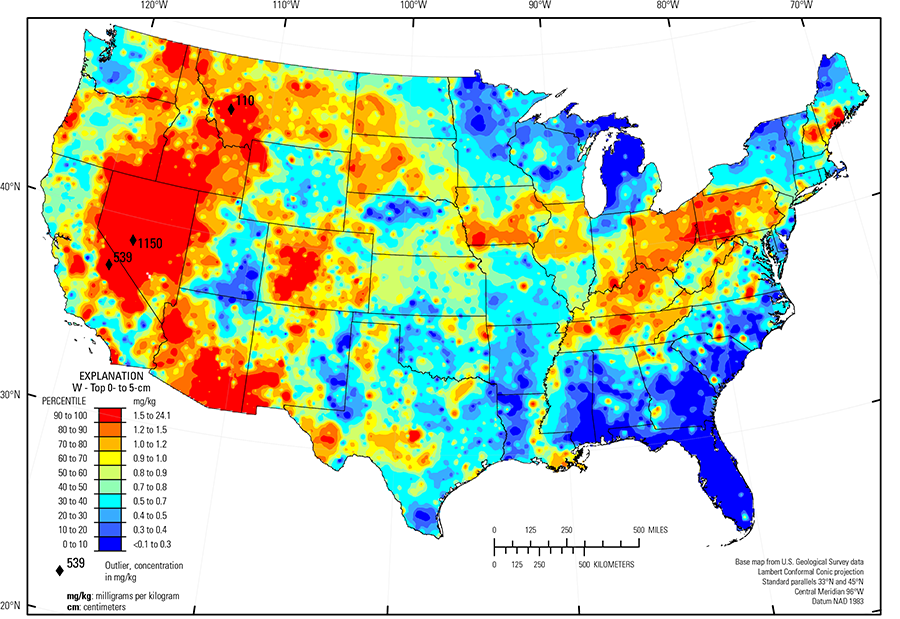
The purpose of these interpretive discussions is to provide a perspective on regional- and national-scale variations in element and mineral distributions in soils and their likely causes. The significant spatial variations shown by most elements and minerals can commonly be attributed to geologic sources in underlying parent materials, but other spatial variations seem clearly related to additional factors such as climate, the age of soils, transported source material, and anthropogenic influences. We attempt to distinguish the influence of these various factors on a regional and national scale. Numerous more local features might similarly be related to these same factors, but these features also have some probability of being an artifact of a random sampling of variable compositions, so that there is some probability of samples with similar compositions occurring in clusters of two or more adjacent sites by chance. Distinguishing such random occurrences from true variability is beyond the scope of the data from which these maps are constructed. Some caution, therefore, is advisable in interpreting the significance of these more local features unless some unique sources or processes can clearly be related to them.
Tungsten (W) is a metallic element that was used extensively for the filaments of incandescent light bulbs. These types of bulbs are being phased out in many countries because they produce more heat than light. Tungsten and its alloys are also used for many high–temperature applications such as arc–welding electrodes and heating elements in high–temperature furnaces. Tungsten carbide is extremely hard and is very important to the metal–working, mining, and petroleum industries where it is used in cutting and drilling tools. Tungsten plays a biological role as a component in enzymes used by bacteria, but it is considered nonessential and nontoxic for humans. More information about the toxicity of W (or other elements and substances) and its potential negative human health impacts can be found at the Agency for Toxic Substances and Disease Registry (ATSDR) website, or click to download a fact sheet about W.
Tungsten in soils is largely inherited from parent materials. Because W does not substitute into most rock–forming minerals, its distribution in soils is related largely to naturally occurring W mineralization. The average abundance of W in the Earth's upper continental crust is estimated to be approximately 1.4 milligrams per kilogram (mg/kg) (Hu and Gao, 2008). Mineral deposits enriched in W are widespread throughout the western United States and are most often genetically related to intrusions of felsic rocks, such as granite or granodiorite, which have, on average, about 1.5 mg/kg W. Tungsten–bearing fluids emanating from felsic intrusions may precipitate in rocks both distal and proximal to the intrusion. The principal W ore minerals are scheelite (CaWO4) and wolframite ((Fe,Mn)WO4). Both scheelite and wolframite are brittle and fairly insoluble in water, which causes them to break down into fine particles during erosion and transport, and may then be dispersed as fine sediment (Hobbs and Elliott, 1973). Sedimentary rocks, such as shale or sandstone, and unconsolidated materials, such as alluvial, eolian, or glacial deposits, all may contain some W, if W was present in source materials. Of the common sedimentary rock types, shale contains, on average, 1.8 mg/kg W, sandstone 1.0 mg/kg, and limestone 0.5 mg/kg.
Statistics and information on the worldwide supply of, demand for, and flow of W–bearing materials are available through the U.S. Geological Survey (USGS) National Minerals Information Center (NMIC) website. The distribution of mineral resource deposits with W as a commodity (major or minor) in the United States, extracted from the USGS Mineral Resource Data System (MRDS) website, can be seen by hovering the mouse here.
In our data, the median concentration of W is 0.9 mg/kg in the soil C horizon and 0.8 mg/kg in both the soil A horizon and the top 0- to 5-cm layer (see the summary statistics [open in new window]). Less than 3 percent of all samples have concentrations less than the lower limit of determination (LLD) of 0.1 mg/kg. Anomalously high W concentrations in the soil C horizon (one site), the soil A horizon (three sites), and the top 0- to 5-cm layers (three sites) were removed prior to constructing the interpolated maps and are shown as diamond symbols. The broad spatial map patterns for W among the three soil layers are generally similar to one another, although profound differences are present in some local areas.
Geographic areas that include felsic bedrock naturally enriched in W and sediments derived from similar rocks that are soil parent materials include:
- Basin and Range (Fenneman and Johnson, 1946), where major metallogenic provinces related to granitic rocks are characterized by gold (Au), W, antimony (Sb), and mercury (Hg) mineralization;
- Southern Sierra Nevada Mountains and Southern California Mountains (USDA, 2006), where granitic and altered rocks contain numerous W deposits;
- Areas in the Central and Southern Rocky Mountains (USDA, 2006), which includes the Colorado Mineral Belt and the Butte mineral district, in Montana; and
- Northern Washington and Idaho, where W mineralization is likely related to geologically young felsic rocks.
Elevated W concentrations occurring in soils developed on alluvial sediments in the Sacramento and San Joaquin Valleys (USDA, 2006) are perhaps derived from granite eroded from the Sierra Nevada Mountains (USDA, 2006). Soils developed on shale in western South Dakota and western North Dakota, and on cyclic beds of shale and sandstone or associated colluvium in western Pennsylvania, West Virginia, Kentucky, and Tennessee can contain elevated W concentrations. Soils with slight W enrichment compared to surrounding areas occur across southern Iowa, south of the southern glacial limit (Soller and others, 2012). These soils formed largely in silty, fine, windblown loess sheets.
The Gulf and Atlantic Coastal Plain (Fenneman and Johnson, 1946) is bisected by the Southern Mississippi River Alluvium and the Southern Mississippi Valley Loess (USDA, 2006). Alluvial sediments have deposited in the Mississippi River valley as the river flooded in recent geologic time. When these sediments dried, winds picked up the fine material and deposited it in thick loess sheets, mainly along the east side of the river valley. The youngest loess sheets are about 10,000 years old. A pattern of higher W concentrations in soil developed on these young sediments reflects long–range transport of W–bearing material from the upper part of the Mississippi River drainage basin
Soils with low concentrations of W developed in areas where W was present only in low concentrations in the soil parent materials. These areas (and dominant soil parent materials) include:
- Colorado Plateau (USDA, 2006) (quartz–rich sandstone and sandy eolian deposits);
- Texas carbonate terrane (limestone, dolostone, chalk, and marl);
- Nebraska Sand Hills (USDA, 2006) (unconsolidated sand dunes and sand sheets, with soils dominated by quartz and plagioclase feldspar);
- Florida (marine carbonate bedrock and sands); and
- The glaciated Upper Great Lakes region in Minnesota, Michigan, and Wisconsin (sandy glacial materials).
Statistics - 0 TO 5 CM
| Number of samples | 4,841 |
| LLD | 0.1 mg/kg |
| Number below LLD | 72 |
| Minimum | <0.1 mg/kg |
| 5 percentile | 0.2 mg/kg |
| 25 percentile | 0.5 mg/kg |
| 50 percentile | 0.8 mg/kg |
| 75 percentile | 1.1 mg/kg |
| 95 percentile | 2.1 mg/kg |
| Maximum | 1,150 mg/kg |
| MAD | 0.445 mg/kg |
| Robust CV | 55.6% |
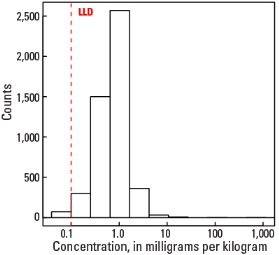
Histogram
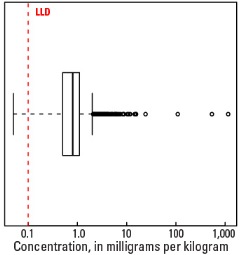
Boxplot
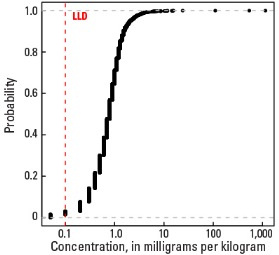
Empirical cumulative distribution function
Statistics - A Horizon
| Number of samples | 4,813 |
| LLD | 0.1 mg/kg |
| Number below LLD | 61 |
| Minimum | <0.1 mg/kg |
| 5 percentile | 0.2 mg/kg |
| 25 percentile | 0.5 mg/kg |
| 50 percentile | 0.8 mg/kg |
| 75 percentile | 1.1 mg/kg |
| 95 percentile | 2.1 mg/kg |
| Maximum | 299 mg/kg |
| MAD | 0.445 mg/kg |
| Robust CV | 55.6 % |
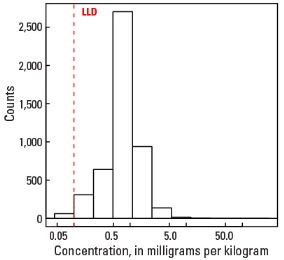
Histogram
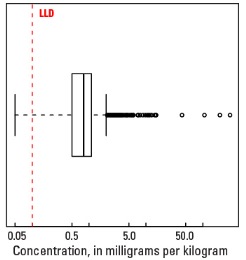
Boxplot
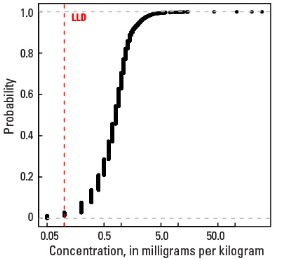
Empirical cumulative distribution function
Statistics - C Horizon
| Number of samples | 4,780 |
| LLD | 0.1 mg/kg |
| Number below LLD | 140 |
| Minimum | <0.1 mg/kg |
| 5 percentile | 0.2 mg/kg |
| 25 percentile | 0.6 mg/kg |
| 50 percentile | 0.9 mg/kg |
| 75 percentile | 1.3 mg/kg |
| 95 percentile | 2.6 mg/kg |
| Maximum | 199 mg/kg |
| MAD | 0.445 mg/kg |
| Robust CV | 49.4 % |

Histogram
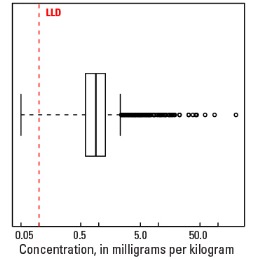
Boxplot
